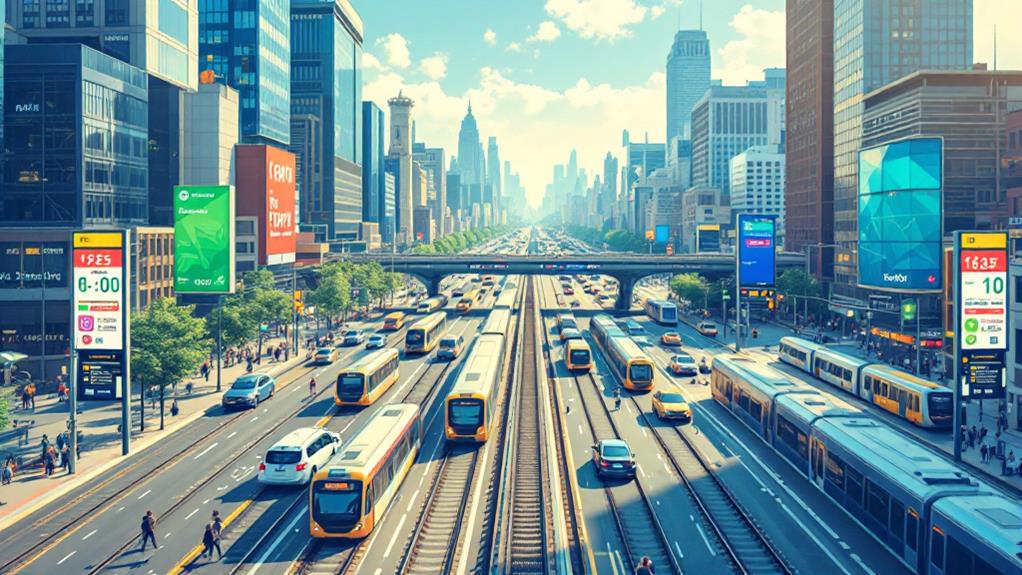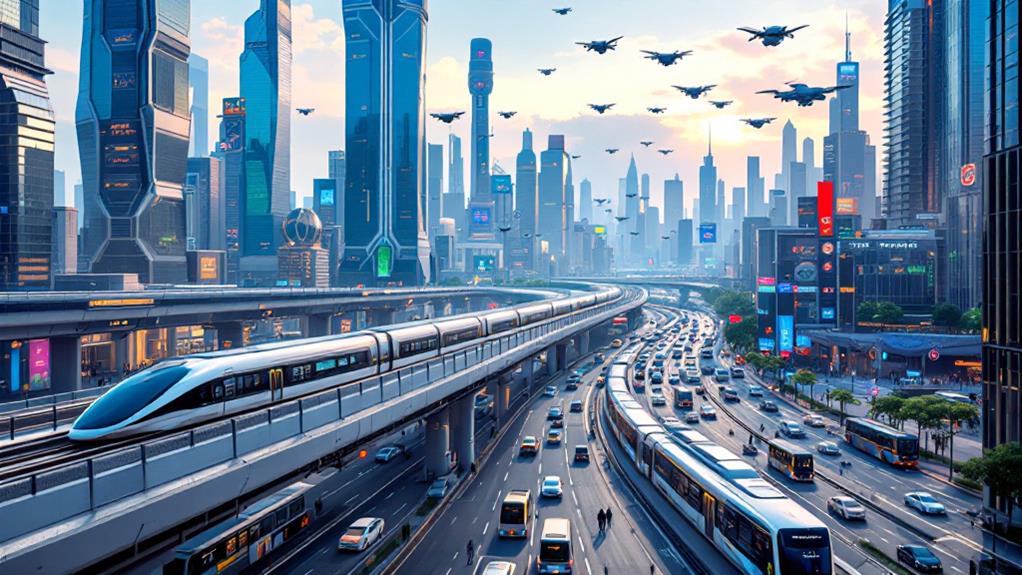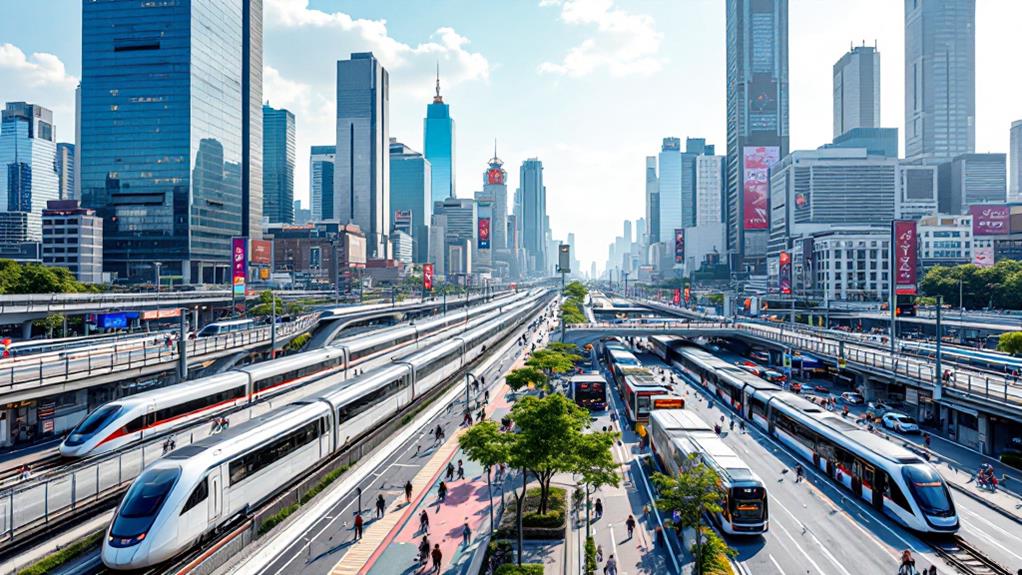Transportation in the Largest Cities: Navigating Urban Transit Systems

Maneuvering urban transit systems in the largest cities involves understanding diverse challenges and solutions. You're dealing with increasing congestion, funding pressures, and the need for accessibility. Cities like Hong Kong and Bogotá showcase successful models with extensive transit networks, while technological advancements like smart ticketing offer potential for improved efficiency. The impact of ride-hailing services and pandemic-induced telecommuting continues to affect transit ridership. Planning strategies now focus on centralization and multimodal transportation to enhance service and connectivity. Investigate further to reveal insights into how urban planners are innovating to meet these complex demands effectively.
Urban Transit Challenges
Amidst growing urbanization and population surges, urban transit systems face significant challenges in maintaining efficiency and accessibility. You're witnessing this firsthand in Texas, where public transportation networks struggle under the weight of nearly 4 million new residents added over the past decade. With this population growth, the demand on urban transport has intensified, yet transit ridership has paradoxically declined. Factors such as rising operating expenses, lower gas prices, and the affordability of cars have drawn people away from reliable public transport options.
The COVID-19 pandemic further exacerbated these issues, with transit ridership plummeting due to safety concerns and service limitations. For instance, Houston Metro saw a dramatic 53.6% drop in December 2020 compared to the previous year. As a result, traffic congestion continues to worsen, highlighting the pressing need for effective solutions in urban transport.
Moreover, emerging technologies like ride-hailing services threaten to reduce public transit ridership by 25% by 2050, challenging traditional models and funding. If you're relying on public transportation networks, these dynamics may affect your daily commute, making it essential for systems to adapt and become more efficient to meet growing demands.
Types of Transit Systems
Texas's public transportation landscape is diverse, consisting of rural transit districts, urban transit districts, and metropolitan transit authorities (MTAs). Each plays a vital role in the state's transportation systems. Rural transit districts cater to communities under 50,000 residents, often using demand-response services to meet mobility needs. Urban transit districts serve areas with populations between 50,000 and 199,999, such as Bryan-College Station, which handled 6.7 million trips in fiscal 2019. MTAs, like Houston Metro and DART, operate in larger urban areas and can levy local sales taxes, supporting their extensive mobility infrastructure.
Consider these highlights:
- Rural Transit Districts: Focus on demand-response services.
- Urban Transit Districts: Serve medium-sized cities, maintaining indispensable ridership levels.
- Metropolitan Transit Authorities: Serve large urban areas, leveraging sales taxes for funding.
- Operating Costs: Nearly $2.5 billion statewide in fiscal 2019, reflecting financial challenges.
Public transit systems across Texas face the task of maintaining ridership levels amid shifting urban dynamics. With eight MTAs, including Houston Metro, reporting high passenger trips and significant operating costs, the pressure is on to adapt and innovate. By understanding the structure and scope of these districts, you can appreciate their contributions to urban mobility infrastructure.
Funding and Revenue Sources

When exploring how Texas funds its urban transit systems, it's clear that financial sustainability relies on a complex mix of local, state, and federal investments. In fiscal 2019, operating expenses for Texas transit services neared $2.5 billion, pointing to the significant financial pressures on the public transit network. Revenue sources are heavily reliant on these government investments, and fluctuations in ridership and service offerings directly influence funding allocations.
For urban transit systems in metropolitan areas, funding is often determined by population density as per decennial census figures. With the 2020 Census data now available, the impact on future funding allocations will be substantial. This data-driven approach guarantees that resources are distributed according to the needs of growing populations.
Urban transit districts, serving populations between 50,000 to 199,999, face unique financial challenges. These 21 districts showcase the diverse operational costs across regions. However, metropolitan transit authorities (MTAs) in areas with populations over 200,000 have an extra revenue-generating tool: they can levy local sales taxes to support their operations. This strategy is vital for maintaining and expanding transportation services, guaranteeing that the public transit network remains robust and responsive to the needs of Texas's metropolitan areas.
Technological Impacts on Transit
Technology is reshaping the landscape of urban transit, challenging traditional models and driving innovation. As a commuter, you're witnessing a transformation in how transport systems operate and serve the public. Ride-hailing services like Lyft and Uber are cutting into public transit ridership, projecting a 25% reduction by 2050. This technological impact is reshaping the competitive dynamics of transit systems. Meanwhile, the COVID-19 pandemic has intensified telecommuting trends, reducing the need for public transit as 33% of the U.S. workforce worked from home in October 2020.
Technological advancements are enhancing urban transit in numerous ways:
- Multimodal transport integration: Systems like DART combine buses, commuter rail, and light rail, improving transit appeal.
- Data-driven design: This approach can slash bus trip times by an average of 23 minutes, optimizing efficiency.
- Smart ticketing systems: These are transforming public transit operations and enhancing user experience.
- Enhanced data analytics: Route optimization and service delivery improvements are changing how systems function.
These innovations aim to make public transport more appealing and efficient, ensuring that urban transit systems continue to evolve in line with technological progress.
Future of Public Transportation

Imagine stepping into a future where public transportation is not just a necessity but a seamless, integrated part of daily urban life. City planners are reimagining the public transport system to guarantee it's both a reliable public service and a driver of sustainable mobility. The COVID-19 pandemic highlighted vulnerabilities in ridership, with systems like Houston Metro seeing a sharp decline due to safety concerns. Yet, this challenge presents an opportunity to create.
You'll find that multimodalism is at the core of these advancements, combining buses, commuter rail, and light rail to make transit more appealing and accessible. With 33% of the U.S. workforce telecommuting full-time as of October 2020, traditional ridership patterns are changing. City planners are taking this into account, crafting systems that adapt to these new demands.
Local, state, and federal decisions are crucial in shaping the future of public transportation. Strategic planning and creative approaches are critical, as evidenced by voter support for transit initiatives in cities like Austin and San Antonio. This community backing emphasizes the need for improved services to accommodate growing populations, guaranteeing that public transport remains a reliable and fundamental part of urban life.
Measuring Transport Accessibility
As cities reimagine public transportation to adapt to changing demands, understanding how accessible these systems are becomes a top priority. Measuring transport accessibility involves examining how easily people can reach public transport systems in urban areas. Accessibility metrics emphasize not just the proximity to transit stations but also the frequency and capacity of services.
- Less than 50% of the global urban population is conveniently near frequent public transport, affecting economic opportunities.
- High population densities often demand better transport accessibility to reduce reliance on private vehicles.
- Quality of service is vital; it encourages ridership and improves urban productivity.
- Improved accessibility is linked to better road safety and lowered environmental impacts.
Effective public transport systems can transform urban areas by making them more inclusive and reducing the need for private vehicles. You play a role in advocating for systems that guarantee more people live within easy reach of frequent public transport, as defined by the ITDP's Atlas. Cities like Bogotá and Bilbao have shown how prioritizing accessibility can lead to healthier and more environmentally friendly urban spaces. With quality and quantity in focus, transport initiatives can substantially influence economic and social outcomes in large urban areas.
Successful Global Transport Models

Across the globe, several urban transit systems stand out as exemplary models of efficiency and accessibility. Bogotá's TransMilenio is a leading bus system, ensuring nearly 85% of its residents are within walking distance of frequent transport. This transport network reduces reliance on private vehicle use, ranking it among the top cities globally for access to public transport. Likewise, Bilbao's combination of metro and tram services means 72% of its population lives within a kilometer of rapid transport, achieving the lowest private vehicle use rate in Spain.
In the U.S., Seattle has emerged as a success story by increasing the percentage of residents near frequent city buses and Area Rapid Transit from 25% to 68% within just two years. This growth exemplifies effective public transport strategies, setting Seattle apart as the only major American city to enhance transit ridership during that timeframe. Singapore's groundbreaking approach integrates automated rail systems and self-driving taxis, ensuring seamless public transport while maintaining robust disaster management policies. Finally, Hong Kong's MTR, with over 166 stations, operates with minimal delays, reflecting its top position in the Urban Mobility Readiness Index 2022. These cities illustrate best practices in urban transit systems worldwide.
Centralization in Transit Planning
Building on the success of global transport models, centralization in transit planning emerges as a strategy to advance urban mobility. By consolidating fragmented transportation systems, cities can improve service efficiency and the passenger experience. Centralization allows for the integration of data-driven design, where extensive passenger and route data inform decision-making. This integration not only optimizes urban transit networks but also supports network expansion, as seen with TransJakarta's 2016 improvements. By centralizing fare collection and other infrastructure, they increased passenger tap-out rates by 40%.
Consider these benefits of centralization in urban transit planning:
- Improved efficiency: Centralized systems streamline operations, reducing redundancies and improving service quality.
- Augmented data utilization: Extensive data collection facilitates informed decisions, leading to reduced travel times and better passenger experiences.
- Increased public satisfaction: With more reliable services and improved infrastructure, public satisfaction and ridership grow.
- Support for economic development: Effective transit systems elevate local economies by improving access and connectivity.
Centralization transforms urban transport networks by fostering more efficient, data-driven, and passenger-focused transportation systems. As cities adopt these strategies, they can expect better service delivery, optimized network expansion, and ultimately, a more seamless urban transit environment.



